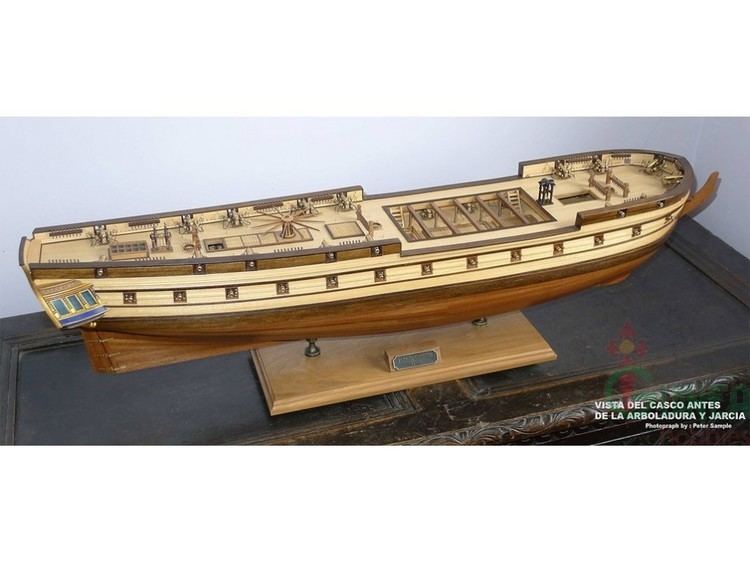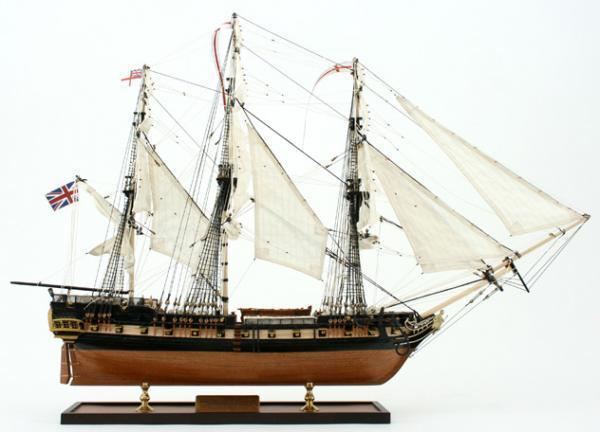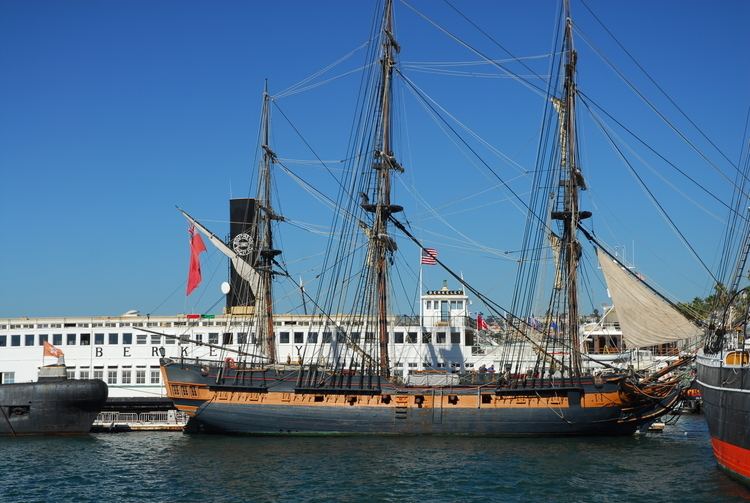Name Unité Commissioned April 1794 Displacement 596,000 kg Launched 16 January 1794 Draft 4.27 m | Laid down August 1793 Length 39 m Construction started August 1793 Weight 667.5 tons | |
 | ||
Captured 20 April 1796by HMS Inconstant | ||
HMS Surprise was the name the Royal Navy gave to the French Navy's corvette Unité after her capture in 1796. Launched on 16 February 1794, the ship gained fame in 1799 for the recapture of HMS Hermione, and in 1802 was sold out of the service.
Contents
- Construction
- French service
- Capture by the Royal Navy
- Recapture of HMS Hermione
- Fate
- Surprise in fiction
- References

Construction

Pierre-Alexandre Forfait designed Unité, the name ship for her class of corvette. Although the French initially rated Unité as a corvette, the ships of her class bridged a gap between smaller warships and frigates, and at various times were rated as frigates.
French service

On 20 March 1794, lieutenant de vaisseau Jean le Drézénec, who was 41 years old and had entered the naval service soon after the revolution from a career in the merchant service, arrived to take command of Unité. He supervised the fitting out of the ship, and found the long guns were too large to be easily reloaded, and the lower sails were also too large. He notified the authorities, who urged him to finish fitting out the ship because a major naval operation was imminent. Soon afterwards, Unité took part in the battle of the Glorious First of June by escorting the dismasted Révolutionnaire as she was towed by the Audacieux.
In June 1794 Unité completed repairs in Saint-Malo and Brest to damage she had sustained in the battle. In the following months she escorted merchant vessels along the coasts of France. On 28 September, with the corvette Bergere and under the command of Lieutenant de Vaisseau Gouley, the two ships left Brest to sail northwest in between Ireland and the islands of the Hebrides and St Kilda to intercept enemy merchant ships. On 17 October, the ships captured a 200-ton merchant ship Dianne. The next day the weather turned foul and the two ships were separated. Unwilling or unable to continue the mission alone, Unité searched for Bergere fruitlessly for sixteen days before finally returning to Brest on 1 November.
Capture by the Royal Navy

After repairs, Unité was ordered to join the Mediterranean fleet at Toulon, and arrived there in March 1795. She spent the remainder of the year either blockaded in port or serving as a courier. In April 1796, she was ordered on one such courier mission to North Africa to deliver personnel and messages to the port of Bône. At the time, Le Drézénec, who had been recently promoted to capitaine de frégate, was suffering from smallpox and was incapacitated. Consequently, her first lieutenant, Lieutenant Le Breton, commanded Unité.

Captain Thomas Fremantle in command of the frigate HMS Inconstant had heard there was a French frigate in Bône, and sailed to intercept her. When Unité arrived in the afternoon of 20 April 1796, the watch aboard Unité identified Inconstant as a neutral vessel and Le Breton did not clear the ship for action. About an hour later, Inconstant sailed alongside, boarded and captured Unité intact.
About a year after capture, Unité was renamed HMS Surprise because another French ship also named Unité had already been taken into the navy. Surprise was re-classed by the British as a 28-gun sixth-rate frigate, though she carried twenty-four 32-pounder carronades on her main deck, eight 32-pounders on her quarter- and fore- decks and two (or four) long 6-pound cannons as chasers. As in the French Navy, this led to difficulty in her rating, considered a fifth rate from 1797 to 1798 but a sixth rate the rest of her commission. Also, she bore the main-mast of a 36-gun ship, just as unusual as her large armament.
Recapture of HMS Hermione
Under Captain Edward Hamilton, Surprise sailed in the Caribbean for several years, capturing several privateers. Surprise gained fame for the cutting-out expedition in 1799 of HMS Hermione. Hermione's crew had mutinied, and had sailed her into the Spanish possession of Puerto Cabello. Captain Edward Hamilton of Surprise led a boarding party to retake Hermione and, after an exceptionally bloody action, sailed her out under Spanish gunfire. The Spanish casualties included 119 dead; 231 were taken prisoner, while another 15 jumped or fell overboard. Hamilton had 11 injured, four seriously, but none killed.
Fate
After the Treaty of Amiens, the Royal Navy sold Surprise out of the service at Deptford in February 1802 and she was broken up.
Surprise in fiction
HMS Surprise was the ship chosen by author Patrick O'Brian to restore Captain "Lucky" Jack Aubrey of the Aubrey–Maturin series to his place as a captain, and eventually see him raise his flag as an admiral of the Royal Navy. Surprise is an important element of the series, both because of her importance to the running plotline, and because of the emotional attachment she has earned among fans of the series.
For the 2003 film Master and Commander: The Far Side of the World, the role of Surprise was filled by the replica of HMS Rose, which was purchased by the film studio and modified for the role. The film relates that Aubrey had served aboard her as a midshipman in 1785, when the real Surprise had not yet been launched. The book HMS Surprise by O'Brian also mentions Aubrey being a midshipman aboard Surprise The series also has the Surprise in service until at least 1812, even though a 38-gun frigate by this name was commissioned in September 1812.
The fictional Surprise is sold out of the service in The Reverse of the Medal, being purchased by Stephen Maturin and employed first as a letter of marque and later as His Majesty's hired ship Surprise under Aubrey's command. Maturin agrees to sell the Surprise to Aubrey in The Nutmeg of Consolation, though later novels suggest that Maturin continues to own the ship. Surprise's ultimate fictional fate is unknown although she was still at sea in Blue at the Mizzen, when Aubrey receives news of his promotion to rear-admiral of the blue in her great cabin at the end of the book.
